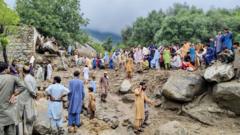The article text:
In a tragic turn of events, heavy monsoon floods and landslides have resulted in the loss of at least 164 lives within the last 24 hours across Pakistan and its administered regions of Kashmir. The most severely affected region is the mountainous Khyber Pakhtunkhwa province in northern Pakistan, where disaster authorities report that 150 deaths have occurred. Moreover, at least 30 homes have been obliterated, and the crisis was further exacerbated by a rescue helicopter incident, which resulted in the deaths of all five crew members on board.
In addition to the fatalities in Khyber Pakhtunkhwa, nine people have lost their lives in Pakistan-administered Kashmir, with a further five casualties reported from the northern Gilgit-Baltistan area. Government forecasters have issued warnings that heavy rainfall is expected to persist until August 21, with specific alerts for the northwestern parts of the country. In response to the catastrophe, several areas have been officially designated as disaster zones.
The chief minister of Khyber Pakhtunkhwa, Ali Amin Gadapur, indicated that the unfortunate crash of a M-17 helicopter, which was engaged in rescue operations over Bajaur near the Afghanistan border, was attributed to treacherous weather conditions. In Bajaur, visuals captured by AFP show a crowd gathered around an excavator working through the muddy terrain, while funeral prayers were conducted in a nearby paddock, where mourners stood over bodies shrouded in blankets.
In the Indian-administered section of Kashmir, rescue teams worked tirelessly on Friday, pulling deceased individuals from mud and debris following a catastrophic flood that swept through a Himalayan village, claiming at least 60 lives and displacing many more.
Monsoon rains, which occur between June and September, contribute to approximately three-quarters of South Asia’s annual precipitation. Unfortunately, landslides and flooding are not uncommon during this season, with over 300 deaths recorded thus far in the current cycle. Notably, in July, Punjab province, which houses nearly half of Pakistan's population of 255 million, saw a striking 73% increase in rainfall compared to last year, resulting in a higher death toll than witnessed in the previous monsoon season. Climate scientists warn that the increasing frequency and intensity of these weather events are direct consequences of climate change, posing an urgent need for environmental action.
In a tragic turn of events, heavy monsoon floods and landslides have resulted in the loss of at least 164 lives within the last 24 hours across Pakistan and its administered regions of Kashmir. The most severely affected region is the mountainous Khyber Pakhtunkhwa province in northern Pakistan, where disaster authorities report that 150 deaths have occurred. Moreover, at least 30 homes have been obliterated, and the crisis was further exacerbated by a rescue helicopter incident, which resulted in the deaths of all five crew members on board.
In addition to the fatalities in Khyber Pakhtunkhwa, nine people have lost their lives in Pakistan-administered Kashmir, with a further five casualties reported from the northern Gilgit-Baltistan area. Government forecasters have issued warnings that heavy rainfall is expected to persist until August 21, with specific alerts for the northwestern parts of the country. In response to the catastrophe, several areas have been officially designated as disaster zones.
The chief minister of Khyber Pakhtunkhwa, Ali Amin Gadapur, indicated that the unfortunate crash of a M-17 helicopter, which was engaged in rescue operations over Bajaur near the Afghanistan border, was attributed to treacherous weather conditions. In Bajaur, visuals captured by AFP show a crowd gathered around an excavator working through the muddy terrain, while funeral prayers were conducted in a nearby paddock, where mourners stood over bodies shrouded in blankets.
In the Indian-administered section of Kashmir, rescue teams worked tirelessly on Friday, pulling deceased individuals from mud and debris following a catastrophic flood that swept through a Himalayan village, claiming at least 60 lives and displacing many more.
Monsoon rains, which occur between June and September, contribute to approximately three-quarters of South Asia’s annual precipitation. Unfortunately, landslides and flooding are not uncommon during this season, with over 300 deaths recorded thus far in the current cycle. Notably, in July, Punjab province, which houses nearly half of Pakistan's population of 255 million, saw a striking 73% increase in rainfall compared to last year, resulting in a higher death toll than witnessed in the previous monsoon season. Climate scientists warn that the increasing frequency and intensity of these weather events are direct consequences of climate change, posing an urgent need for environmental action.



















